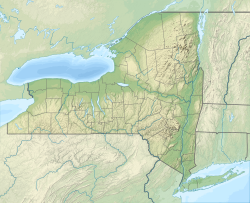This article needs additional citations for verification .(August 2013) |
| Temple Society of Concord | |
|---|---|
 Interior of the synagogue's sanctuary in 2019 | |
| Religion | |
| Affiliation | Reform Judaism |
| Ecclesiastical or organisational status | Synagogue |
| Leadership | Rabbi Ilan Emanuel Cantor Kari Siegel Eglash [1] |
| Status | Active |
| Location | |
| Location | 450 Kimber Road, Syracuse, Onondaga County, New York 13224 [2] |
| Country | United States |
Location in New York | |
| Coordinates | 43°02′42″N76°08′02″W / 43.04507°N 76.13386°W |
| Architecture | |
| Architects |
|
| Type | Synagogue |
| Style | Neo-classical |
| Established | 1839 (as a congregation) |
| Completed | 1911 |
| Construction cost | $100,000 |
| Materials | Limestone |
| Website | |
| templeconcord | |
Temple Society of Concord | |
| NRHP reference No. | 09000259 |
| Added to NRHP | April 27, 2009 |
| [3] | |
The Temple Society of Concord, commonly referred to as Temple Concord, is a Reform Jewish congregation and synagogue located at 450 Kimber Road, in Syracuse, Onondaga County, New York, in the United States. [2]
Contents
- Early history
- Religious leaders and rabbis
- Religious leaders (1841–present)
- Synagogue and related buildings
- Gallery
- See also
- References
- External links
Established in 1839, it is the ninth-oldest active Jewish congregation in the United States. Temple Concord, a member of the Union for Reform Judaism, is the leading Reform synagogue in Central New York, and maintains the largest Jewish religious school in the region.[ citation needed ] Religious services are held every Friday night and Saturday morning, and on Jewish holidays. Religious school and adult education programs take place twice a week. Temple Concord is also the setting for a wide array of educational, cultural and social events the serve then entire Syracuse-area community.[ citation needed ]
The synagogue building was listed on the National Register of Historic Places in 2009; and in 2019 the congregation announced plans to sell the historical synagogue building, due to financial pressures. [4]






